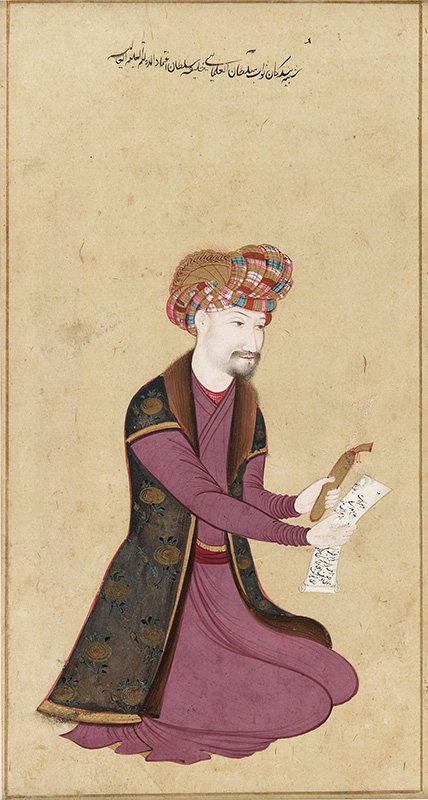Moʿin Moṣavver | Individual Drawings and Paintings
Drawing 1650.4
Portrait of the ʿOlamā, Ḵalifa Solṭān, Eʿtemād al-Dowla
Location: Freer Gallery of At and Arthur M. Sackler Gallery, Smithsonian Institution, Washington D.C.: The Art and History Collection, LTS1995.2.88
Painting: 20.3 x 10.6 cm.
Signature: Unsigned and undated; circa 1650.
Inscription
At the top, reads: šebh-e bandegān-e navāb solṭān alʿolamāi ḵalifa solṭān eʿtemād al-dowla alʿāleya.
Translation: “Likeness of His Excellency, the Sultan of the ʿOlamā, Ḵalifa Sultan, the supporter of the exalted state.” The inscription is unsigned, but plausibly in Moʿin’s handwriting.
Description:
A middle aged man, with a neatly groomed beard, is seated on the ground facing the right. He wears a multi-colored turban, a magenta robe, and a brocaded coat with a fur collar. Both arms are extended before him; in his left hand he holds a money bag, and in his right a scroll of paper, perhaps a petition. The background is a plain light tan.
Bibliography:
Christie’s London, 22 April 1981, Lot 120.
Soudavar, PC_1992, pp.288-89, pl.114.
Commentary:
The painting, which is inscribed at the top in Moʿin’s hand, is an excellent example of the artist’s work, and can be attributed to him without reservation, even though the inscription is unsigned. The only doubt concerning the miniature is its date of execution. Sultan Ḵalifa (1593-1653), one of the most important statesmen of Safavid times, is portrayed in his middle years. Thus, a date of 1640 would be the earliest one might consider, but if painted from life, circa 1650 might be more likely. Soudovar elaborates in some detail the lineage and offices held by Sultan Ḵalifa and his family. For another portrait, presumably of about the same date, with which this painting shares some features in common, cf. 1650.3.
Photo courtesy of the Freer Gallery of At and Arthur M. Sackler Gallery, Smithsonian Institution
Robert Eng
Last Updated: April 23, 2018 | Originally published: April 23, 2018
